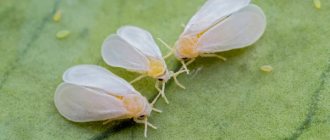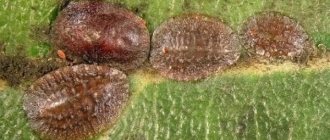Home / Flowers
Back
Published: 07/12/2019
1
Rate this post
The rose is deservedly called the queen of flowers for its beauty and wonderful aroma. Every queen must have servants, and this also applies to roses. It is you who must serve her. If you become negligent in caring for your rose bushes, they will not only not give you beautiful flowers, but they may even die.
The same thing can happen if you do not protect the bushes from the invasion of enemies, and the queen of flowers has more than enough of them. These are diseases, as well as harmful insects. How can you fight and win against them?
When treating roses against pests with chemicals, you only need to wear clothes made of thick fabric, rubber gloves, goggles, and be sure to use a respirator. Wrap your head in a scarf. After completing work, wash your face and hands with soap, or better yet, take a hot shower.
Pests on roses appear in early spring, when the buds just begin to swell. They torment the beauty until late autumn. That is why you need to take care of your flower garden throughout the growing season, taking care of them in late autumn, preparing the bushes for a comfortable winter. The same whitefly affects not only garden but also indoor flowers.
Rose pests drain the vitality of plants and make flowers vulnerable to disease. If you find small enemies that cause great damage to the garden, fight them immediately.
- 1 Tracks
- 2 Roseate sawflies
- 3 Rose aphid
- 4 Slobbery Penny
- 5 Leafhopper
- 6 Leafrollers
- 7 Spider mite
- 8 Beetles - bronze beetle and fawn
- 9 Leaf Cutter Bee
- 10 Weevil
- 11 Thrips
How to treat roses to combat spider mites
Spider mites on roses (photo)
Spider mites are especially dangerous for roses in dry, hot summers. The optimal conditions for its development are temperatures of +29…+31 °C with air humidity below 35%. Under such conditions, the number of ticks increases rapidly, because every 10-15 days a new generation of the pest appears. Mites suck out the cell sap from the leaves, as a result of which small light spots (pricks) appear on them, the leaves turn yellow, dry out and fall off.
The most effective in the fight against spider mites are Iskra-M and Fufanon. Spraying roses in the presence of a mite must be repeated after 10-12 days until its harmfulness decreases. How else can you treat roses against spider mites to get rid of this pest? At temperatures above +22 °C, colloidal sulfur or “Tiovit Jet” can be used. These drugs inhibit the reproduction of ticks.
Treatment of roses, as well as other plants, should be carried out in the evening or morning hours. If simultaneous protection against diseases and pests is necessary, all recommended insecticides can be mixed with fungicides immediately before spraying, except Bordeaux mixture.
Look at the photo of this rose pest and measures to combat it:
Black spot (lat. Marssonina)
Caused by the fungus Marssonina rosae, when it gets on a plant it affects the leaf blade, flower petals and sepals. The spores are carried by water droplets and black spotting develops in July and August.
How to recognize the disease
Small dark spots appear on diseased plants, which quickly increase in diameter to 15 mm. Conidia with fungal spores form on them. Leaves fall in sequence from top to bottom. The rose weakens and gradually dies.
Black spot almost completely destroys leaves
Black spot on roses treatment and prevention measures
- Leaves and shoots affected by black spot are cut off; they cannot be sent to compost, so they are burned;
- Diseased roses are treated with fungicides containing copper and zinc (“Fundazol”, “Kaptan”);
- In the fall, before covering the plants for the winter, they are sprayed with 3% copper or iron sulfate.
Leaf-cutter bee rose pest: photos and control measures
On the leaves of roses and rose hips at the end of June-July you can see regularly cut oval or completely round holes.
Rose pest leafcutter bee in the photo
This is the job of the leafcutter bee, which uses them to build its nest. Having chosen a suitable ready-made cavity - an abandoned bee burrow, a barbel burrow or an earthworm burrow, the bee begins to stuff it with carelessly cut pieces of rough leaves of oak, grape, or hawthorn. This plug serves to protect the nest.
After the cork is made, the bee begins to cut out oval pieces of the more delicate leaves of roses, lilacs, acacias, and rose hips. Sitting on the sheet, she carefully “cuts” it, like scissors, starting from the edge and gradually turning in a circle. First, the outer layer of the cell is made from large leaves, covering about a third of the circumference of the channel, so that the individual pieces overlap each other, and their lower ends are folded in, forming the bottom of the cell. After this, the builder closes the gaps remaining between the first pieces with smaller pieces of leaves and thickens the walls.
As you can see in the photo, this rose pest, in order to seal a cell filled with food, cuts out completely round pieces of leaves:
In this case, the diameter of the first of them is exactly equal to the diameter of the cell, and the subsequent ones are cut out large and turn out to be concave inward, forming the bottom of the next cell. The first cell is followed by the second and so on. The largest nest of a leafcutter bee has up to 17 cells. In total, it takes more than 1,000 pieces of leaves to build the nest, including the plug.
The finished nest of a leaf-cutter bee is a long cylinder that easily breaks down into individual cells. The leaves from which each one is made are easy to disassemble. Later, this is more difficult to do, since, when pupating, the larva releases a sticky liquid into the spaces between the pieces of leaves, which, when solidified, holds them together.
You can protect roses from this bee by spraying the plants in the late evening with one of the systemic preparations that destroy aphids and other pests.
Try proven insect repellents (including aphids):











